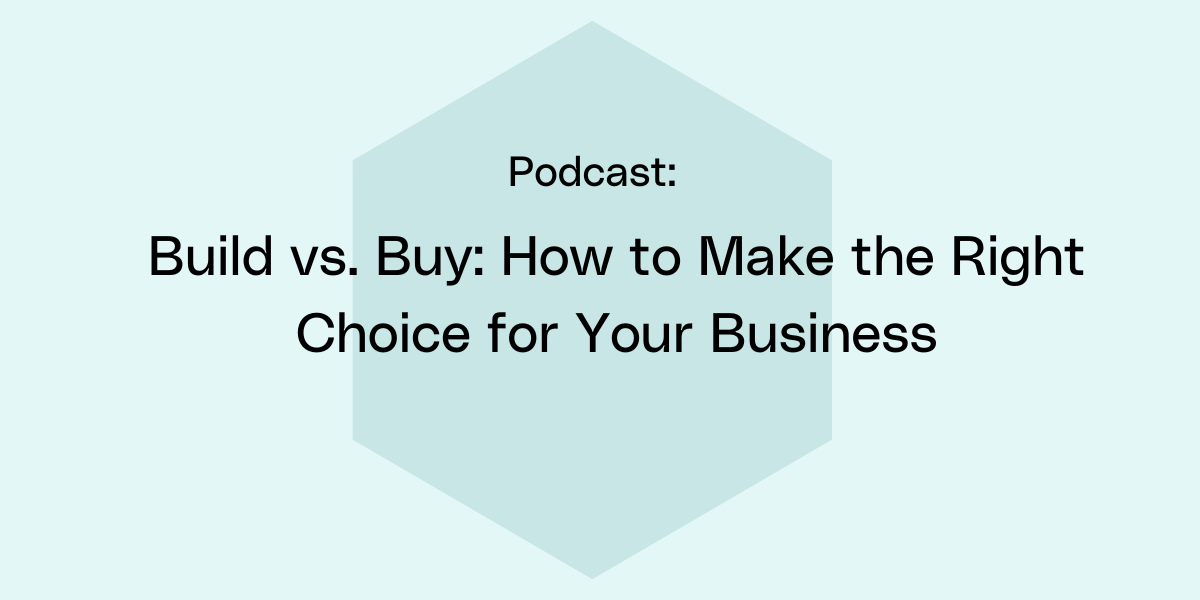The “build vs. buy” dilemma is one of the most complex decisions that businesses face today. With factors like cost, quality, and internal capacity at play, making the right call can be overwhelming. Add to that the rapid pace of technological advancements and the growing pressure to innovate, and it's no surprise that many businesses feel stuck.
To shed light on this challenge, we recently spoke with Richard Masters, Vice President of Data & AI at Virgin Atlantic, about how the aviation industry approaches the “build vs. buy” dilemma. While their approach is tailored to aviation, the underlying principles apply across industries. Here are key takeaways from our conversation to help guide your decision-making.
Understand Your Business Context
The foundation of any decision is understanding your unique environment. And the same is true with the “build vs. buy” dilemma. As Richard reminds us,
“I think something to be conscious of when you're leading data and AI teams is really having as best understanding as you can and continuing to improve that understanding of the industry you're in. And airlines are really interesting ones because we have such dependency on the wider ecosystem. We don't necessarily own the full journey of someone.”
Before making a decision, consider how your internal systems and external partnerships interact. Some solutions might not align with the needs of your key stakeholders.
“Whether we might build something really great for us, it might not serve the needs of some of our joint venture partners,” Richard adds.
This highlights the strategic complexity of the “build vs. buy” dilemma. It’s not just about what works for you. It’s about ensuring long-term compatibility across the ecosystem you operate in.
Focus on Long-Term Goals Over Technology Constraints
While technology plays a huge role in the “build vs. buy” decision, Richard stresses that it shouldn’t dictate your approach. Your long-term goals should.
He explains, “Whether we partner, whether we build, whether we buy, it shouldn't really be constrained by the technology, but the approach is more constrained by what do we really want to do in terms of a process and how can we move quickly as an airline.”
This highlights an important principle: Technology should serve your strategy, not define it. Virgin Atlantic’s approach is a reminder that your decisions should not be shaped by what’s available out there in terms of technology but by how well the solution can help you move towards tomorrow.
Build or buy, it’s about the bigger picture. What will help you move faster, smarter, and more effectively in the long run?
People at the Core of Every Decision
Technology should empower the people who drive your business, not replace or hinder them. Richard explains Virgin Atlantic’s approach to choosing technology: “Our people are first for us. So actually anything that's going to really augment and compliment them.”
This perfectly underscores the importance of human-centred decision-making. In a world where technology is rapidly evolving, it’s easy to lose sight of the role of people. But at the core of every decision, we must ask: How does this choice improve the capabilities of our people? The right technology can augment your team’s strengths and help them thrive, which, in turn, drives the business forward.
Customer Experience Comes First
At the end of the day, customer experience must come first. Richard highlights another critical aspect of Virgin Atlantic’s strategy for introducing new technology: “We don't have anything GenAI in front of our customers at the moment because the big focus at the moment is around guardrails and how we really make sure that it is doing what we need it to do—what's the right usage of it for our customers and for our people, our crew, and our pilots.”
The principle applies universally, regardless of the industry. When introducing new technology, whether built or bought, it’s essential that it improves the customer experience, not complicates it.
If you choose to build, you gain complete control over development, but it may take longer. You have full control over the development, but it may be slower. On the other hand, buying a solution may be faster, but it could disrupt the needs of your customers. Customer experience should be your guiding factor in making the right choice.
Final Thoughts
The “build vs. buy” is a complex decision, but ultimately, it’s about what moves your business forward. The right choice aligns with your vision, empowers your people, and delivers value to your customers.
To ensure your team has the necessary skills to make these critical technology-related decisions, Cambridge Spark’s upskilling programmes are designed to equip them with AI and data expertise. With expert-led training, your workforce will gain the confidence and knowledge needed to make informed choices, ensuring long-term innovation and success.
